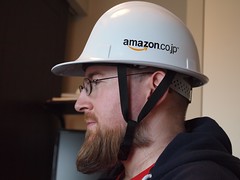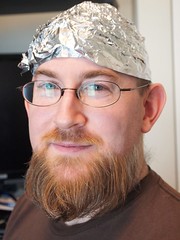In the past few days there has been a lot of confusion about what has been going on. I wrote a bit about my experience in the big earthquake and then later a bit about food shortages, and strange things I am eating. I touched a bit there on the supply problems and issues with nuclear reactors in the north east, but I’ll focus a bit more on that in this post.
So first, initially I was wearing my anti-earthquake hat (+1 for saving throws vs. falling rocks.) Friday was crazy with earthquakes. The first was very scary, but Tokyo pulled through very well. Friday night there were many earthquakes, but none as powerful as the first one. Saturday there were also lots of earthquakes. Sunday there were fewer. I started noticing more in the news about the nuclear power plants in Fukushima. There were still tremors, and Tokyo is feeling the side-effects of the earthquake. Really the problems we have faced are with transportation and electricity. Trains are running at reduced capacity. There are scheduled blackouts for much of Northern Japan. Areas around Tokyo have also seen blackouts but the main center of Tokyo, the “23 wards” have been spared. That would be like all of New York state having scheduled blackouts, but Manhattan being spared due likely to concerns about business and population density. In fact, we are going to reverse evacuate my sister-in-law to Tokyo from a place that is about an hour and a half out of Tokyo further away from the North East because they have been having two blackouts a day and we have had none. Trains are pretty much running now, although at slightly reduced capacity, and at least the major parts of Tokyo have regular electric, gas, and water service. Our elevators are even back at home, although the escalators and elevators at the local shopping center are off to conserve energy.
The other issue is food and gas. Gas is tight right now. Mostly people were panicked and trying to get fuel to get out of Tokyo. That has made it hard for the emergency workers to get fuel to go help out where there is real trouble – up near Sendai and further north east. I think that has taken care of itself now though since people are less worried about radiation and are just staying in Tokyo trying to get back to business as usual. Most companies still have people going to work. Amazon is a bit rare in that we can work from home (that it is allowed, and that we have a kind of job where that actually works well.) I have seen some other email from other friends in Japan saying that if they want to work from home, they can, but they will need to fill in a form and get it stamped by one or two people. That sounds like Japan to me. Everything here needs to be stamped to be official. So yay for Amazon Japan, they have just been really amazing throughout this whole thing.
So I can attest that while we might be a bit inconvenienced and eating strange foods, day to day life is fine. My wife is home because Disneyland (where she is a nurse) is closed for an indeterminate amount of time. What has been more concerning is people over-reacting to the fear of radioactivity from the explosions at the Fukushima nuclear power plants, about 300km away from Tokyo. The news here has been pretty good about getting information out. As of right now (2011-03-17 10:40am JST) I do not think there is any danger to Tokyo from the Nuclear power plants.
Here are some resources I have been using to get information:
- MIT NSE Nuclear Information Hub. A curated blog by MIT students and professors with a lot of information. I trust MIT, and their stuff seems to be very informative with a science (not fear) bent.
- As of the 15th, this post by Paul Atkinson makes it seem like Britain has no fears of radiation.
- As of the 16th the US Embassy also says there is no danger to Tokyo. They also say that TEPCO (Tokyo Electric Power Corp.) has been upfront about the disaster and their information accurate. This reassures me that there are international orgs watching the situation and that we are getting good information.
- The Australian Government has some advice for Australians in Japan. They suggest expanding the exclusion zone from 30km to 50km. Tokyo is 300km from the power plant sites.
I’ve kept an eye out on Facebook where friends in Japan are posting up relevant information as they see it. I like this pictures showing radiation readings in Tokyo. Right now the level is at about 0.2 microsieverts per hour. Eating one banana is 0.1 microsieverts (assuming you eat one banana a day for a year.) Andy Heather has a good blog post about this.
I am convinced that unless there are disastrous changes in the situation, Tokyo will be fine. We are getting good information on the situation on the news, but even a worst-case scenario, a meltdown like at Three Mile Island, we should not see any negative effects in Tokyo. Of course, if you are within the 30km exclusion zone around Fukushima, there is danger. It isn’t going to instantly kill you, but the professionals are on the situation and taking care of it.
There is no way there will be problems in the US from this. As long as we are careful about not eating food from the surrounding area – which is what I gather a lot of the problem from Chernobyl was from – there should be no problems. Chernobyl did not even have the external containment vessel that these power plants have. Lots of eyes are on this, and the professionals are doing their best to keep the radiation contained. I have my tv on, and am watching a few sources, but I think things will be fine.
On to another major subject. Why am I not worried about earthquakes in Japan? First, read this blog post by an engineer in Japan. It is a really good description of how things went right. I totally agree. We have an earthquake warning system. I usually see a warning about 10 seconds before an earthquake hits, assuming I have my TV on. Realistically, this isn’t too helpful, but it has helped me get on my hard hat or put down a bowl of burning soup before the shaking starts. That is really impressive though: advance warning for a natural disaster.
The other thing that makes me feel safe is the building engineering. I’ll use the building that we live in. It was built two years ago, just about. This website lists the safety features of our building. You can run it through Google’s translation service. Actually that doesn’t really help, but we’ve got 56 230cm diameter pylons driven very deep (28 meters) into the bedrock, and the whole building is made to sway with earthquakes. Why does our small two bedroom apartment cost half a million dollars? Because the entire building can dance with an earthquake. This video shows skyscrapers swaying in the earthquake. By design. It feels very, very strange when you are in one, but they do this by design and Japan has poured lots of research and effort into building design. This site has some general information on earthquake and building design. I should see if my architect friends have more information. I know most skyscrapers in Japan use base isolators.
At any rate, Tokyo is doing pretty well. The north east is horribly devastated and could really use more of the focus an attention that is currently being spent on the Nuclear power plant. It seems like that is not as big a problem as people fear. I’ll still keep my anti-radiation hat handy though, so please don’t worry. I can make all sorts of hats as necessary, and possibly radiation-proof my earthquake hat as well.




Leave a Reply